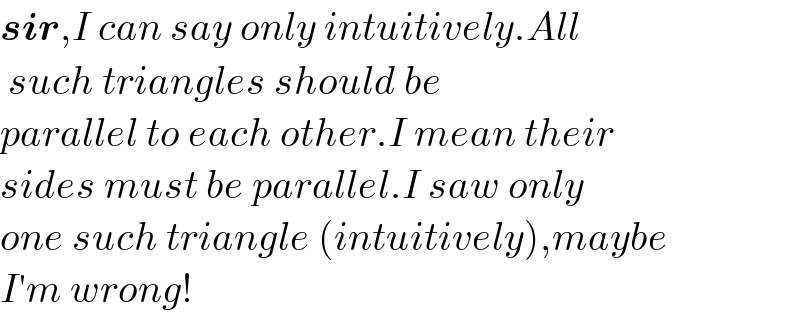Question Number 169815 by mr W last updated on 09/May/22

Commented by mr W last updated on 10/May/22

$${can}\:{you}\:{please}\:{give}\:{a}\:{explanation}? \\ $$
Commented by mr W last updated on 09/May/22

$${Given}\:{a}\:{triangle}\:\Delta{ABC}\:{with}\:{sides} \\ $$$${a},{b},{c}. \\ $$$${Find}\:{the}\:{maximum}\:{area}\:{of}\:{the}\: \\ $$$${inscribed}\:{triangle}\:{whose}\:{sides}\:{are} \\ $$$${perpendicular}\:{to}\:{the}\:{sides}\:{of}\:\Delta{ABC} \\ $$$${as}\:{shown}. \\ $$
Commented by Rasheed.Sindhi last updated on 10/May/22

$${I}\:{think}\:{at}\:{most}\:{only}\:\:{one}\:{such}\:{traingle} \\ $$$$\:{is}\:{possible}. \\ $$
Commented by mr W last updated on 10/May/22

$${you}\:{are}\:{right}\:{sir}. \\ $$
Commented by Rasheed.Sindhi last updated on 10/May/22

$$\boldsymbol{{sir}},{I}\:{can}\:{say}\:{only}\:{intuitively}.{All} \\ $$$$\:{such}\:{triangles}\:{should}\:{be} \\ $$$${parallel}\:{to}\:{each}\:{other}.{I}\:{mean}\:{their} \\ $$$${sides}\:{must}\:{be}\:{parallel}.{I}\:{saw}\:{only} \\ $$$${one}\:{such}\:{triangle}\:\left({intuitively}\right),{maybe} \\ $$$${I}'{m}\:{wrong}! \\ $$
Commented by Rasheed.Sindhi last updated on 10/May/22

$$\mathcal{TH}{an}\mathcal{X}\:\mathcal{S}{ir}! \\ $$
Commented by mr W last updated on 10/May/22

Commented by mr W last updated on 10/May/22

$${if}\:{such}\:{a}\:{triangle}\:{exists},\:{say}\:{the}\:{red} \\ $$$${one},\:{then}\:{it}\:{exists}\:{only}\:{one}\:{time}. \\ $$$${we}\:{can}\:{get}\:{two}\:{sides}\:\left({blue}\right)\:{parallel} \\ $$$${to}\:{the}\:{sides}\:{of}\:{red}\:{triangle},\:{but}\:{the} \\ $$$${third}\:{side}\:\left({green}\right)\:{is}\:{no}\:{longer}\: \\ $$$${parallel}\:{to}\:{the}\:{corresponding}\:{red} \\ $$$${triangle}\:{side}.\:{i}.{e}.\:{the}\:{red}\:{triangle} \\ $$$${is}\:{unique}. \\ $$
Answered by mr W last updated on 10/May/22

Commented by mr W last updated on 10/May/22

$${we}\:{can}\:{see}\:{that} \\ $$$$\Delta{QRP}\sim\Delta{ABC} \\ $$$$\Rightarrow\frac{{p}}{{c}}=\frac{{q}}{{a}}=\frac{{r}}{{b}}={k},\:{say} \\ $$$${a}=\frac{{q}}{\mathrm{tan}\:{B}}+\frac{{r}}{\mathrm{sin}\:{C}} \\ $$$${a}=\frac{{ka}}{\mathrm{tan}\:{B}}+\frac{{kb}}{\mathrm{sin}\:{C}} \\ $$$${a}\left(\frac{\mathrm{1}}{{k}}−\frac{\mathrm{1}}{\mathrm{tan}\:{B}}\right)=\frac{{b}}{\mathrm{sin}\:{C}} \\ $$$$\Rightarrow\frac{{a}\left(\mathrm{sin}\:{B}−{k}\:\mathrm{cos}\:{B}\right)}{{k}\:\mathrm{sin}\:{B}}=\frac{{b}}{\mathrm{sin}\:{C}}\:\:\:…\left({i}\right) \\ $$$${similarly} \\ $$$$\Rightarrow\frac{{b}\left(\mathrm{sin}\:{C}−{k}\:\mathrm{cos}\:{C}\right)}{{k}\:\mathrm{sin}\:{C}}=\frac{{c}}{\mathrm{sin}\:{A}}\:\:\:…\left({ii}\right) \\ $$$$\Rightarrow\frac{{c}\left(\mathrm{sin}\:{A}−{k}\:\mathrm{cos}\:{A}\right)}{{k}\:\mathrm{sin}\:{A}}=\frac{{a}}{\mathrm{sin}\:{B}}\:\:\:…\left({iii}\right) \\ $$$$\left({i}\right)×\left({ii}\right)×\left({iii}\right): \\ $$$$\frac{\left(\mathrm{sin}\:{A}−{k}\:\mathrm{cos}\:{A}\right)\left(\mathrm{sin}\:{B}−{k}\:\mathrm{cos}\:{B}\right)\left(\mathrm{sin}\:{C}−{k}\:\mathrm{cos}\:{C}\right)}{{k}^{\mathrm{3}} }=\mathrm{1} \\ $$$$\left(\mathrm{1}+\mathrm{cos}\:{A}\:\mathrm{cos}\:{B}\:\mathrm{cos}\:{C}\right){k}^{\mathrm{3}} −\left(\mathrm{sin}\:{A}\:\mathrm{sin}\:{B}\:\mathrm{sin}\:{C}\right){k}^{\mathrm{2}} +\left(\mathrm{1}+\mathrm{cos}\:{A}\:\mathrm{cos}\:{B}\:\mathrm{cos}\:{C}\right){k}−\mathrm{sin}\:{A}\:\mathrm{sin}\:{B}\:\mathrm{sin}\:{C}=\mathrm{0} \\ $$$$\left({k}−\frac{\mathrm{sin}\:{A}\:\mathrm{sin}\:{B}\:\mathrm{sin}\:{C}}{\mathrm{1}+\mathrm{cos}\:{A}\:\mathrm{cos}\:{B}\:\mathrm{cos}\:{C}}\right)\left({k}^{\mathrm{2}} +\mathrm{1}\right)=\mathrm{0} \\ $$$$\Rightarrow{k}=\frac{\mathrm{sin}\:{A}\:\mathrm{sin}\:{B}\:\mathrm{sin}\:{C}}{\mathrm{1}+\mathrm{cos}\:{A}\:\mathrm{cos}\:{B}\:\mathrm{cos}\:{C}} \\ $$$$\Rightarrow{k}=\frac{\mathrm{2}\:\mathrm{sin}\:{A}\:\mathrm{sin}\:{B}\:\mathrm{sin}\:{C}}{\mathrm{sin}^{\mathrm{2}} \:{A}+\mathrm{sin}^{\mathrm{2}} \:{B}+\mathrm{sin}^{\mathrm{2}} \:{C}} \\ $$$$\mathrm{sin}\:{A}=\frac{{a}}{\mathrm{2}{R}},\:\mathrm{sin}\:{B}=\frac{{b}}{\mathrm{2}{R}},\:\mathrm{sin}\:{C}=\frac{{c}}{\mathrm{2}{R}} \\ $$$$\Rightarrow\mathrm{sin}\:{A}\:\mathrm{sin}\:{B}\:\mathrm{sin}\:{C}=\frac{{abc}}{\mathrm{8}{R}^{\mathrm{3}} } \\ $$$$\Rightarrow\mathrm{sin}^{\mathrm{2}} \:{A}+\mathrm{sin}^{\mathrm{2}} \:{B}+\mathrm{sin}^{\mathrm{2}} \:{C}=\frac{{a}^{\mathrm{2}} +{b}^{\mathrm{2}} +{c}^{\mathrm{2}} }{\mathrm{4}{R}^{\mathrm{2}} } \\ $$$${k}=\frac{{abc}}{\mathrm{8}{R}^{\mathrm{3}} }×\frac{\mathrm{8}{R}^{\mathrm{2}} }{{a}^{\mathrm{2}} +{b}^{\mathrm{2}} +{c}^{\mathrm{2}} } \\ $$$${k}=\frac{{abc}}{\left({a}^{\mathrm{2}} +{b}^{\mathrm{2}} +{c}^{\mathrm{2}} \right){R}} \\ $$$$\Rightarrow{k}=\frac{\mathrm{4}\Delta_{{ABC}} }{{a}^{\mathrm{2}} +{b}^{\mathrm{2}} +{c}^{\mathrm{2}} } \\ $$$$\Delta_{{PQR}} ={k}^{\mathrm{2}} \Delta_{{ABC}} =\frac{\mathrm{16}\Delta_{{ABC}} ^{\mathrm{3}} }{\left({a}^{\mathrm{2}} +{b}^{\mathrm{2}} +{c}^{\mathrm{2}} \right)^{\mathrm{2}} }\:\checkmark \\ $$
Commented by Tawa11 last updated on 08/Oct/22

$$\mathrm{Great}\:\mathrm{sir} \\ $$
